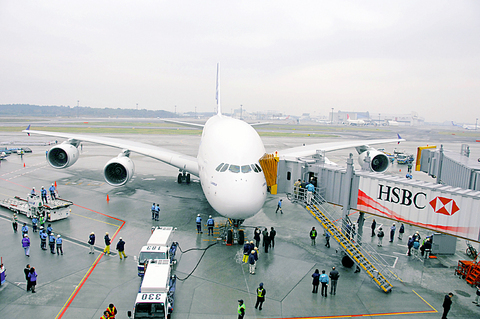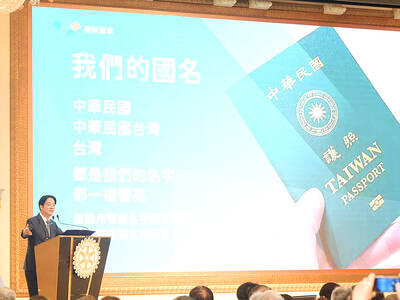An Airbus A380 landed in Japan yesterday, as part of a final series of test flights intended to lead to the superjumbo's air-worthiness certification by the end of the year.
The plane, which is on an Asian tour and flew from Hong Kong, arrived safely in Narita International Airport near Tokyo, airport spokesman Masaharu Watanabe said.
The final four flights in the test schedule, ending Nov. 30, are designed to put the 555-seater A380 through 150 hours of flights under the kind of operating conditions it will experience with airlines. Yesterday's arrival is part of the second of the four trips.

PHOTO: AFP
During its Narita stopover, aviation officials will make sure the huge aircraft can fit the facility and equipment at the airport, while going through a series of routine work such as maintenance, fueling and attaching a boarding bridge, Watanabe said.
"It's the first time for Narita to accommodate such a big plane," Watanabe said. "We have to make sure if the plane fits the facility."
The airport's observation balcony was crowded with many Japanese aviation enthusiasts who were taking pictures of the A380, he said.
"I'm hoping to go down to the spot later and take a look," he said.
The superjumbo will return to France on Monday, before taking off again for Chinese airports in Beijing, Shanghai and Guangdong next week, Airbus said in a statement. It will then fly to South Africa, Australia and Canada in the coming weeks.
The company has said the A380 is on track for certification by the middle of next month.
Airbus has received orders for 166 superjumbo jets. Singapore Airlines will be the first carrier to fly the superjumbo after it receives its first plane next October.

LONG FLIGHT: The jets would be flown by US pilots, with Taiwanese copilots in the two-seat F-16D variant to help familiarize them with the aircraft, the source said The US is expected to fly 10 Lockheed Martin F-16C/D Block 70/72 jets to Taiwan over the coming months to fulfill a long-awaited order of 66 aircraft, a defense official said yesterday. Word that the first batch of the jets would be delivered soon was welcome news to Taiwan, which has become concerned about delays in the delivery of US arms amid rising military tensions with China. Speaking on condition of anonymity, the official said the initial tranche of the nation’s F-16s are rolling off assembly lines in the US and would be flown under their own power to Taiwan by way

OBJECTS AT SEA: Satellites with synthetic-aperture radar could aid in the detection of small Chinese boats attempting to illegally enter Taiwan, the space agency head said Taiwan aims to send the nation’s first low Earth orbit (LEO) satellite into space in 2027, while the first Formosat-8 and Formosat-9 spacecraft are to be launched in October and 2028 respectively, the National Science and Technology Council said yesterday. The council laid out its space development plan in a report reviewed by members of the legislature’s Education and Culture Committee. Six LEO satellites would be produced in the initial phase, with the first one, the B5G-1A, scheduled to be launched in 2027, the council said in the report. Regarding the second satellite, the B5G-1B, the government plans to work with private contractors

‘OF COURSE A COUNTRY’: The president outlined that Taiwan has all the necessary features of a nation, including citizens, land, government and sovereignty President William Lai (賴清德) discussed the meaning of “nation” during a speech in New Taipei City last night, emphasizing that Taiwan is a country as he condemned China’s misinterpretation of UN Resolution 2758. The speech was the first in a series of 10 that Lai is scheduled to give across Taiwan. It is the responsibility of Taiwanese citizens to stand united to defend their national sovereignty, democracy, liberty, way of life and the future of the next generation, Lai said. This is the most important legacy the people of this era could pass on to future generations, he said. Lai went on to discuss

MISSION: The Indo-Pacific region is ‘the priority theater,’ where the task of deterrence extends across the entire region, including Taiwan, the US Pacific Fleet commander said The US Navy’s “mission of deterrence” in the Indo-Pacific theater applies to Taiwan, Pacific Fleet Commander Admiral Stephen Koehler told the South China Sea Conference on Tuesday. The conference, organized by the Center for Strategic and International Studies (CSIS), is an international platform for senior officials and experts from countries with security interests in the region. “The Pacific Fleet’s mission is to deter aggression across the Western Pacific, together with our allies and partners, and to prevail in combat if necessary, Koehler said in the event’s keynote speech. “That mission of deterrence applies regionwide — including the South China Sea and Taiwan,” he